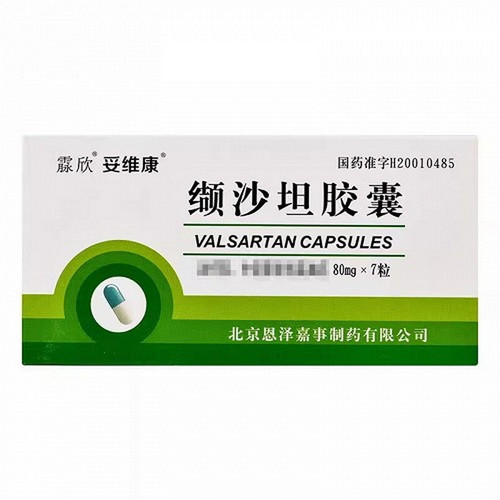Product Overview
[Drug Name]
Generic Name: Valsartan and Hydrochlorothiazide Capsules
Trade Name: Lanpu
English Name: Valsartan and Hydrochlorothiazide Capsules
Chinese Pinyin: Xiashatan Qinglusaiqin Jiaonang
[Ingredients]
This product is a combination preparation of valsartan and hydrochlorothiazide.
[Properties]
This product is a capsule containing white or off-white granules.
[Indications]
For the treatment of mild to moderate essential hypertension in patients whose blood pressure cannot be adequately controlled with a single medication.
[Dosage and Administration]
When valsartan monotherapy is inadequately controlling blood pressure, or when hydrochlorothiazide 25 mg once daily is insufficient, or when hypokalemia occurs, this product (containing valsartan 80 mg/hydrochlorothiazide 12.5 mg) can be used as an alternative, one capsule once daily. Maximum antihypertensive efficacy is achieved within 2-4 weeks of treatment. This product can be taken regardless of mealtimes. No dose adjustment is required for patients with mild to moderate renal failure (creatinine clearance ≥30 ml/min) or mild to moderate hepatic failure.
[Adverse Reactions]
In two controlled clinical trials involving a total of 1,570 patients, 730 of whom received valsartan in combination with hydrochlorothiazide, the following adverse events were reported: Central Nervous System Common (>5%): Headache (10.8%; placebo 17.2%), dizziness. Uncommon (5-0.1%): Fatigue, depression. Upper Respiratory Tract Uncommon (5-0.1%): Cough, rhinitis, sinusitis, pharyngitis, upper respiratory tract infection, epistaxis. Gastrointestinal Uncommon (5-0.1%): Nausea, diarrhea, dyspepsia, abdominal pain. Lower Urinary Tract Uncommon (5-0.1%): Frequent urination, urinary tract infection. Musculoskeletal Uncommon (5-0.1%): Pain in the arms or legs, arthritis, myalgia, sprains and strains, muscle spasms. Other rare events (5-0.1%): asthenia, chest pain, weakness, viral infection, visual impairment, and conjunctivitis. In controlled clinical trials, the incidence of neutropenia was 1.9% in the valsartan group and 1.6% in the ACEI group. Significant increases in serum creatinine, potassium, and total bilirubin were observed in 0.8%, 4.4%, and 6% of the valsartan group, respectively, and in 1.6%, 6.4%, and 12.9% of the ACEI group, respectively. Elevated liver function tests may occasionally be observed. Specific laboratory monitoring is not required for patients with essential hypertension receiving valsartan.
[Contraindications]
Hypersensitivity to any of the ingredients in this product or to sulfonamide derivatives. Pregnancy (see Pregnancy and Lactation). Severe liver failure, biliary cirrhosis, or cholestasis. Severe renal failure (creatinine clearance <30 ml/min) or anuria. Refractory hypokalemia, hyponatremia, or hypercalcemia, and symptomatic hyperuricemia (history of gout or uric acid stones).
[Precautions]
Caution is advised regarding changes in serum electrolytes when used with potassium-sparing diuretics, potassium supplements, potassium-containing salt substitutes, or other medications that increase serum potassium levels (e.g., heparin). Therefore, serum potassium levels should be monitored regularly. Thiazide diuretics have been associated with hyponatremia and hypochloremic alkalosis. Thiazides can cause hypomagnesemia by increasing renal magnesium excretion. Sodium and/or volume depletion: Rarely, symptomatic hypotension may occur when initiating treatment with this medication in patients with severe sodium and/or volume depletion (e.g., high-dose diuretics). Hyponatremia and/or volume depletion should be corrected before initiating treatment with this medication. If hypotension occurs, the patient should be placed in the supine position and, if necessary, given normal saline. Treatment can be resumed after blood pressure stabilizes. Renal Artery Stenosis: There is no experience with this medication in patients with unilateral or bilateral renal artery stenosis or solitary kidney stenosis. For renal impairment, no dose adjustment is required for patients with a creatinine clearance ≥30 mL/min. Hepatic Impairment: This drug should be used with caution in patients with mild to moderate non-cholestatic hepatic impairment. However, since the daily dose of 80 mg valsartan does not exceed the recommended limit and the pharmacokinetics of hydrochlorothiazide are not significantly affected by hepatic impairment, no dose adjustment is required in such patients. Systemic Lupus Erythematosus: Thiazide diuretics can trigger or exacerbate systemic lupus erythematosus. Other Metabolic Disorders: Thiazide diuretics can impair glucose tolerance and increase serum cholesterol, triglyceride, and uric acid levels. Effects on the ability to drive and operate machinery: As with other antihypertensive drugs, patients taking this drug should exercise caution when driving and operating machinery.
[Use in Special Populations]
Precautions in Pediatrics: Insufficient data are available regarding the therapeutic use of this drug in children.
Precautions during Pregnancy and Lactation: This drug is contraindicated in pregnant women.
Precautions in the Elderly: Some elderly individuals (over 65 years of age) have slightly elevated valsartan concentrations compared to younger volunteers, but these are not clinically significant. Compared with younger patients, elderly patients have higher steady-state concentrations of hydrochlorothiazide and significantly reduced systemic clearance. Therefore, elderly patients receiving hydrochlorothiazide therapy require close monitoring.
[Drug Interactions]
Combination with other antihypertensive medications may enhance the antihypertensive efficacy of this medication. Caution is advised when using this medication with potassium-sparing diuretics, potassium supplements, potassium-containing salt substitutes, or other medications that increase serum potassium (such as heparin), and serum potassium levels should be monitored. There have been reports of reversible increases in serum lithium concentrations and lithium toxicity with the concomitant use of lithium, ACE inhibitors, and/or thiazide diuretics. There is no experience with the concomitant use of valsartan and lithium. Therefore, regular monitoring of serum lithium levels is recommended when lithium and this medication are coadministered. Because this medication contains a thiazide diuretic, the following interactions may occur: Concomitant use with nonsteroidal anti-inflammatory drugs (such as salicylic acid derivatives and indomethacin) may reduce the diuretic and antihypertensive activity of the thiazide component of this medication. Concomitant volume depletion may lead to acute renal failure. Concomitant use of potassium-wasting diuretics (such as furosemide), corticosteroids, adrenocorticotropic hormone (ACTH), amphotericin B, carbenoxolone, penicillin G, or salicylate derivatives can exacerbate potassium and/or magnesium loss. The bioavailability of thiazide diuretics may be increased when anticholinergic drugs (such as atropine and biperiden) are coadministered, possibly due to decreased gastrointestinal motility and slower gastric emptying. There have been isolated reports of hemolytic anemia associated with the combined use of hydrochlorothiazide and methyldopa. Cholestyramine and colestipol reduce the absorption of thiazide diuretics. Concomitant use of thiazide diuretics with vitamin D or calcium salts can enhance the effect of increasing serum calcium. Concomitant use of cyclosporine may increase the risk of hyperuricemia, which can cause symptoms of gout.
[Pharmacological Action]
Valsartan is an orally active, specific angiotensin II (AT) receptor antagonist. It selectively targets the AT1 receptor subtype, with an affinity 20,000-fold greater than that for the AT2 receptor. The AT1 receptor subtype mediates the physiological responses of angiotensin II, while the AT2 receptor subtype is not involved in cardiovascular effects. Valsartan does not exhibit partial agonist activity at the AT1 receptor. In most patients, a single oral dose produces a blood pressure-lowering effect within 2 hours, with peak effect reaching 4-6 hours and maintaining the antihypertensive effect for more than 24 hours after dosing. In long-term treatment, maximal antihypertensive efficacy is achieved after 2-4 weeks and is maintained. Combination with hydrochlorothiazide significantly enhances the antihypertensive effect of valsartan. Abrupt discontinuation of valsartan treatment does not cause "rebound" hypertension or other side effects. Valsartan does not affect fasting total cholesterol, triglycerides, blood glucose, or uric acid levels in hypertensive patients. Valsartan has no inhibitory effect on ACE and does not cause retention of bradykinin and substance P, making it less likely to cause cough. Clinical trials comparing valsartan with ACE inhibitors demonstrated that the incidence of dry cough was significantly lower in the valsartan group (2.6%) than in the ACE inhibitor group (7.9%) (P < 0.05). In a clinical trial of patients who developed dry cough after receiving ACE inhibitors, cough was reported in 19.5% of the valsartan group, 19.0% of the diuretic group, and 68.5% of the ACE inhibitor group (P < 0.05). In controlled clinical trials, the incidence of cough in patients treated with valsartan and hydrochlorothiazide was 2.9%. Valsartan has no effect on other hormone receptors or ion channels known to play an important role in cardiovascular regulation. Valsartan lowers elevated blood pressure without affecting heart rate. Hydrochlorothiazide: Hydrochlorothiazide acts by inhibiting the co-transport of sodium and chloride ions. Competing for chloride ion sites can affect electrolyte reabsorption, directly increasing sodium and chloride excretion and indirectly reducing plasma volume, which in turn increases plasma renin activity, aldosterone secretion, and potassium excretion, leading to lower serum potassium. Because the renin-aldosterone system is angiotensin II-dependent, combined use of angiotensin II receptor antagonists can reduce potassium loss associated with thiazide diuretics. Controlled clinical trials have shown that the combined use of valsartan/hydrochlorothiazide has a clear antihypertensive effect, more potent than either drug alone.
Storage: Store at room temperature, tightly closed.
Specifications: Each tablet contains 80mg of valsartan and 12.5mg of hydrochlorothiazide.
Packaging: Box
Expiration Date: 24 months
Approval Number: National Medical Products Administration H20051634
Manufacturer: Chenxin Pharmaceutical Co., Ltd.







